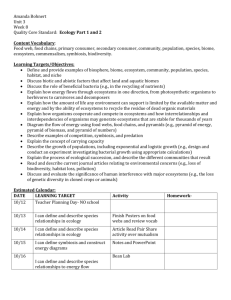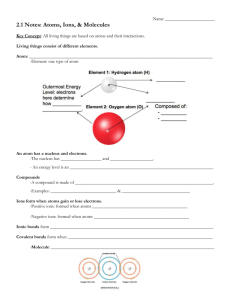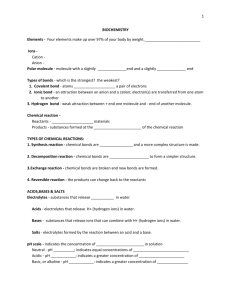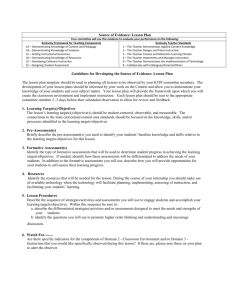Week 6 Sept 14-18
advertisement
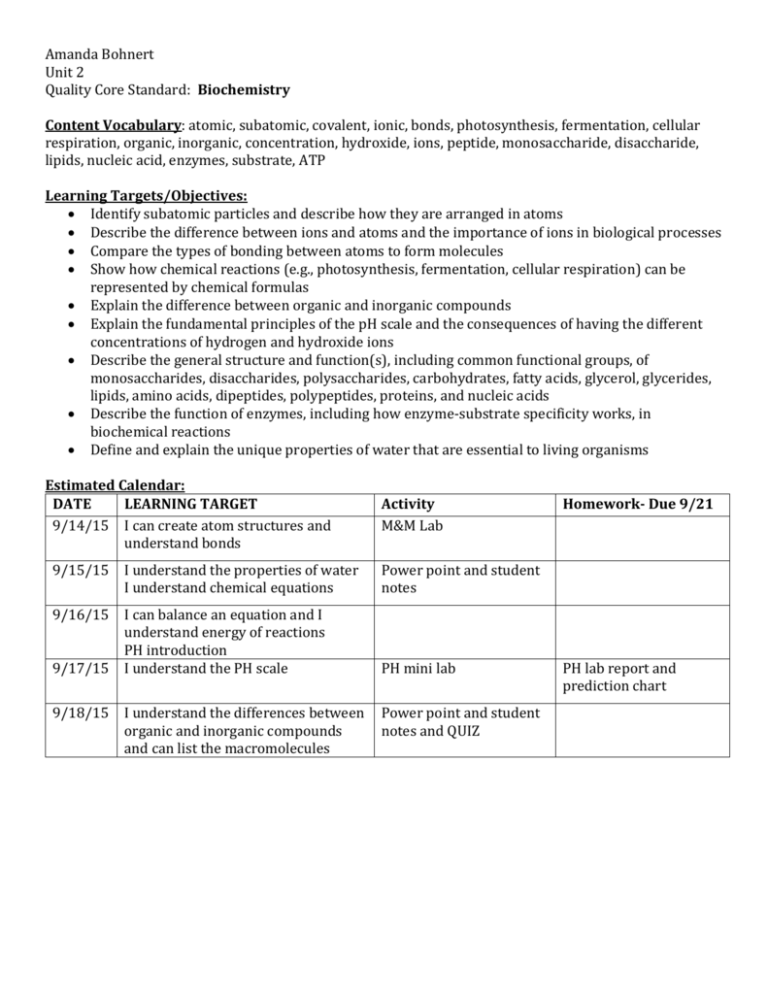
Amanda Bohnert Unit 2 Quality Core Standard: Biochemistry Content Vocabulary: atomic, subatomic, covalent, ionic, bonds, photosynthesis, fermentation, cellular respiration, organic, inorganic, concentration, hydroxide, ions, peptide, monosaccharide, disaccharide, lipids, nucleic acid, enzymes, substrate, ATP Learning Targets/Objectives: Identify subatomic particles and describe how they are arranged in atoms Describe the difference between ions and atoms and the importance of ions in biological processes Compare the types of bonding between atoms to form molecules Show how chemical reactions (e.g., photosynthesis, fermentation, cellular respiration) can be represented by chemical formulas Explain the difference between organic and inorganic compounds Explain the fundamental principles of the pH scale and the consequences of having the different concentrations of hydrogen and hydroxide ions Describe the general structure and function(s), including common functional groups, of monosaccharides, disaccharides, polysaccharides, carbohydrates, fatty acids, glycerol, glycerides, lipids, amino acids, dipeptides, polypeptides, proteins, and nucleic acids Describe the function of enzymes, including how enzyme-substrate specificity works, in biochemical reactions Define and explain the unique properties of water that are essential to living organisms Estimated Calendar: DATE LEARNING TARGET 9/14/15 I can create atom structures and understand bonds Activity M&M Lab 9/15/15 I understand the properties of water I understand chemical equations Power point and student notes 9/16/15 I can balance an equation and I understand energy of reactions PH introduction I understand the PH scale PH mini lab 9/17/15 9/18/15 I understand the differences between organic and inorganic compounds and can list the macromolecules Power point and student notes and QUIZ Homework- Due 9/21 PH lab report and prediction chart Individual Lesson Plans: Target I can create atom structures and understand bonds Lesson Title: Biochemistry Pre-Assessment How many “open bond sites” does Oxygen have? Hint: look at the valence electron number and think about how many more it needs to be stable Answer: 2 – oxygen has 8 electrons total (atomic number). 2 of them will go in the first electron shell and 6 of them will go in the last shell. You need 8 total to be stable in the outer shell—there are 2 open sites for bonding Formative Assessment Polling Resources Power point with student hand out notes Exit slip: What are the two types of bonds and how do they work? Notes: Lesson Procedures: Individual Lesson Plans: Target I understand the properties of water I understand chemical equations Lesson Title: Biochemistry Pre-Assessment How many valence electrons does Bromine have? Answer: 7 Formative Assessment Resources Power point with student hand out notes Exit slip: What are two properties of water? Notes: Individual Lesson Plans: Target understand energy of reactions and PH Lesson Title: Biochemistry Pre-Assessment Answer: What is polarity? Formative Assessment polling Resources Power point and student notes Exit slip: Due to polarity, water forms weak bonds that are known as what? Notes: Individual Lesson Plans: Target I understand the PH scale Lesson Title: Biochemistry Pre-Assessment Acid solutions have more OH- or H+ ions? Formative Assessment Answer: H+ Resources PH mini lab Exit slip: A PH of 8 is considered what? Notes: HW – lab report on PH lab Individual Lesson Plans: Target I understand the differences between organic and inorganic compounds Lesson Title: Biochemistry Pre-Assessment Answer: Formative Assessment Resources Exit slip: Notes: Quiz today (bonds, Atoms, Valence Electrons, PH, water properties)
